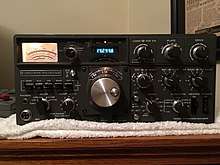Kenwood TS-820S

The Kenwood TS-820S is a model of amateur radio transceiver produced primarily by the Kenwood Corporation from the late 1970s into the 1980s; some were produced by Trio Electronics before Kenwood's 1986 name change). The transceiver's predecessor was the TS-520, which began production a year earlier. The TS-820S was the second of three hybrid (including vacuum tubes and semiconductors) models produced by Kenwood during the 1970s and 1980s,[1] and was noted for its quality. Its functionality and new hybrid technology made it one of the most popular transceivers marketed to amateurs in the late 1970s and early 1980s. The TS-820S has a built-in power supply, so it can be plugged directly into a 120V wall outlet.
Variants
The TS-820 did not have an LED frequency counter, but was otherwise identical to the 820S.[2] The TS-820S was the most sophisticated (and common) variant.[2] The TS-820X, unavailable in the United States, was primarily produced in Japan.
Functions
The transceiver (as its name implies) can transmit and receive on the HF 10-, 15-, 20-, 40-, 80- and 160-meter bands,[3] and can receive WWV and WWVH on 15 MHz. It can use SSB, FSK and CW on all bands.[3] The TS-820S' power consumption is 57 watts (with heaters on) when receiving and 292 watts when transmitting. The transceiver's peak envelope power output on SSB and CW is about 100 watts, and about 60 watts on FSK. Its tubes are tuned manually, using the transceiver's drive, plate and load controls.
Specifications
General
- Frequency range: 1.8-2.0 MHz, 3.5-4.0 MHz, 7.0-7.3 MHz, 14.0-14.35 MHz, 21.0-21.45 MHz, 28.0-28.5 MHz, 28.5-29.0 MHz, 29.0-29.5 MHz, 29.5-29.7 MHz; receives WWV and WWVH on 15 MHz
- Power supply: 120/220 VAC
- Modes (receive and transmit): LSB, USB, FSK, CW
- Power consumption: 57 watts (receive, heaters on); 292 watts (transmit)
- Antenna impedance: 50–75 ohms
- Antenna Connector: SO-239
- Weight: 35.2 pounds (16.0 kg)[3]
- Dimensions: Width 333 millimetres (13.1 in), height 153 millimetres (6.0 in), depth 335 millimetres (13.2 in)[3]
- Features: Digital frequency counter, VOX, noise blanker, receiver incremental tuning (RIT), IF shift, RF attenuation[4]
Receiver and transmitter
- Stability: May drift up to 100 Hz in 30 minutes after the radio has warmed up, or up to 1 kHz in one hour after one minute of warm-up; the transceiver stabilizes when warmed up.
- Audio-frequency response: 400–2600 Hz (with original filters and correct alignment)
- Bandwidth: 2.4 kHz on SSB, 500 Hz on CW (with original filters and correct alignment)[3]
See also
References
- ↑ Benedict, James (2016). "Vintage Hybrid Receivers". eHam.
- 1 2 Kenwood Corporation (1970–80). Kenwood TS-820S Instruction Maual. Kenwood Corporation. p. 2.
- 1 2 3 4 5 Kenwood Corporation (1970–80). Kenwood TS-820S Instruction Manual. Kenwood Corporation. p. 3.
- ↑ "RigPix Database - Kenwood/Trio - TS-820S". www.rigpix.com. Retrieved 2018-05-20.